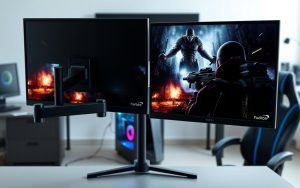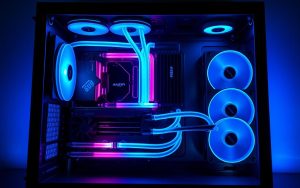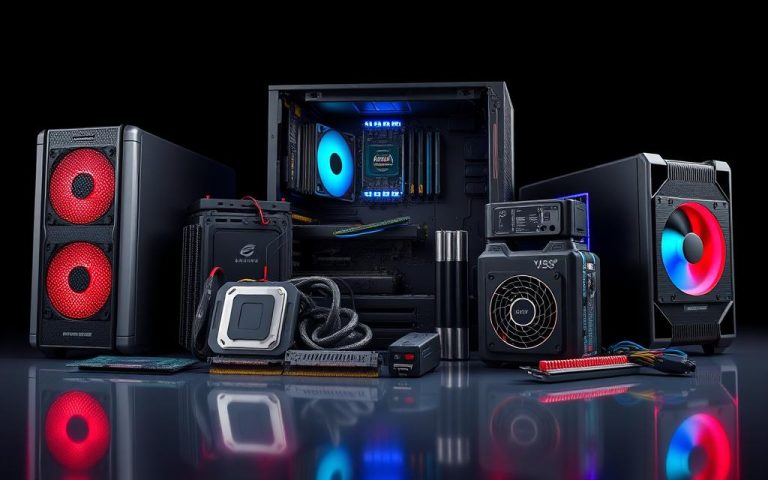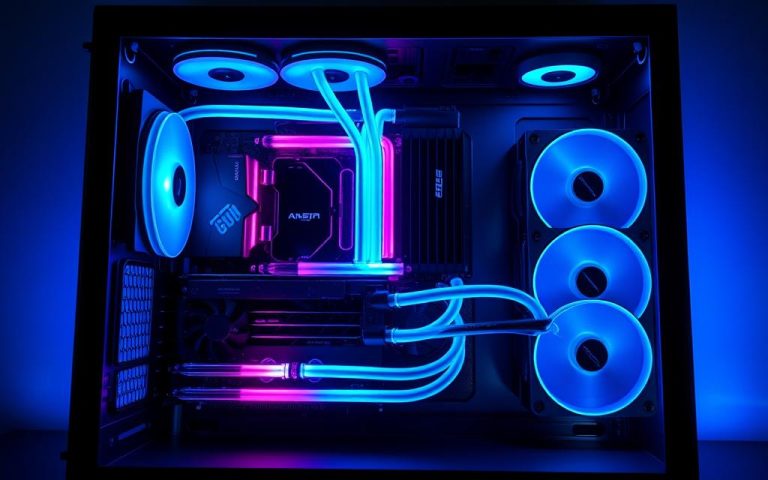Gaming PC Monitors: How Much Do They Cost?
Choosing the right display for your setup can be overwhelming. Prices vary widely, from budget-friendly options under $200 to premium models exceeding $1,000. Key factors like resolution, refresh rate, and panel type significantly impact cost.
Entry-level screens, such as the Samsung 24-Inch CF396, start around $110. Mid-range picks like the ViewSonic Omni VX2728J-2K offer solid performance near $180. For competitive players, high-refresh displays like the HP Omen 27k deliver smooth gameplay at $479.
This guide breaks down pricing by category, helping you find the best value. Whether you prioritize speed, clarity, or immersive visuals, there’s a perfect fit for every budget.
What Makes a Great Gaming Monitor?
Selecting the perfect display involves balancing performance, visuals, and budget. Key specs like refresh rate, resolution, and panel technology define the experience. Let’s break down what truly matters.
Refresh Rate and Response Time
Smooth gameplay starts with high refresh rates. Competitive players benefit from 144Hz or higher, reducing motion blur. The HP Omen 27k excels here with a 144Hz refresh rate.
Response time is equally crucial. Aim for 1ms to 5ms for crisp visuals during fast action. Slower times can cause ghosting, especially in FPS or racing games.
Resolution and Panel Technology
Clarity varies across resolutions:
- 1080p: Budget-friendly with high frame rates
- 1440p: Sharp detail without heavy GPU demands
- 4K: Ultra-crisp visuals for immersive play
Panel types impact visuals differently. IPS delivers vibrant colors and wide viewing angles, ideal for the HP Omen 32q. VA panels, like in the Cooler Master GM34-CWQ, offer deeper blacks for horror games.
Samsung’s Odyssey Neo G8 pushes boundaries with OLED tech. It combines rich contrast with lightning-fast response. For HDR performance, panel choice matters—VA often outperforms IPS in contrast.
As PCWorld notes, balancing these features ensures the best experience. Whether you prioritize speed or visuals, understanding specs helps maximize value.
How Much Is a Gaming PC Monitor? Price Ranges Explained
Price tags vary dramatically across different display categories. From budget gaming options under $200 to elite screens surpassing $1,000, understanding tiers helps maximize value.
Entry-level picks like the BenQ EX2510S deliver 1080p clarity below $200. For sharper visuals, the ViewSonic VX2728J-2K stands out at $179 with 1440p resolution—a steal for cheap gaming monitors.
Mid-range models ($200-$500) balance performance and cost. The HP Omen 32q offers 1440p and 165Hz refresh rates near $350. Beyond $500, gains become marginal. The Gigabyte M27Q X excels, but prices climb for niche features like OLED.
Seasonal discounts on Amazon and Newegg can slash costs. The Acer Nitro 27″ often drops to $199, rivaling premium specs. Console displays sometimes work for PCs, though used options may lack adaptive sync.
Ultimately, smart shoppers prioritize refresh rates and panel types over raw resolution. Whether upgrading or building fresh, there’s a perfect fit for every wallet.
Budget Gaming Monitors Under $200
Affordable displays don’t have to sacrifice performance. Today’s market offers impressive 1080p and 1440p options below $200, perfect for value-focused players. Let’s explore top picks that balance cost and capability.
BenQ Mobiuz EX2510S: Best 1080p Budget Pick
The BenQ Mobiuz EX2510S delivers crisp 1080p visuals at 165Hz, ideal for fast-paced titles. Its IPS panel ensures vibrant colors, while AMD FreeSync Premium eliminates screen tearing. At under $150, it’s a steal for competitive play.
ViewSonic Omni VX2728J-2K: Best 1440p Budget Pick
For sharper detail, the ViewSonic Omni VX2728J-2K stands out. This 27-inch QHD display boasts a 180 refresh rate, rivaling pricier models. Brightness peaks at 250 nits—sufficient for most rooms but limited for HDR.
How does it compare to the HP X27q? Here’s a quick breakdown:
| Feature | ViewSonic Omni VX2728J-2K | HP X27q |
|---|---|---|
| Price | $179.99 | $249 |
| Refresh Rate | 180Hz | 165Hz |
| Brightness | 250 nits | 350 nits |
Pair either with an RX 6700 XT or RTX 3060 Ti for smooth 1440p gameplay. For alternatives, the Acer Nitro KG271U N3 offers similar specs under $200.
Mid-Range Gaming Monitors ($200-$500)
Mid-range displays strike the perfect balance between performance and affordability. These models offer sharper resolutions, higher refresh rates, and advanced features like adaptive sync—ideal for players ready to upgrade.
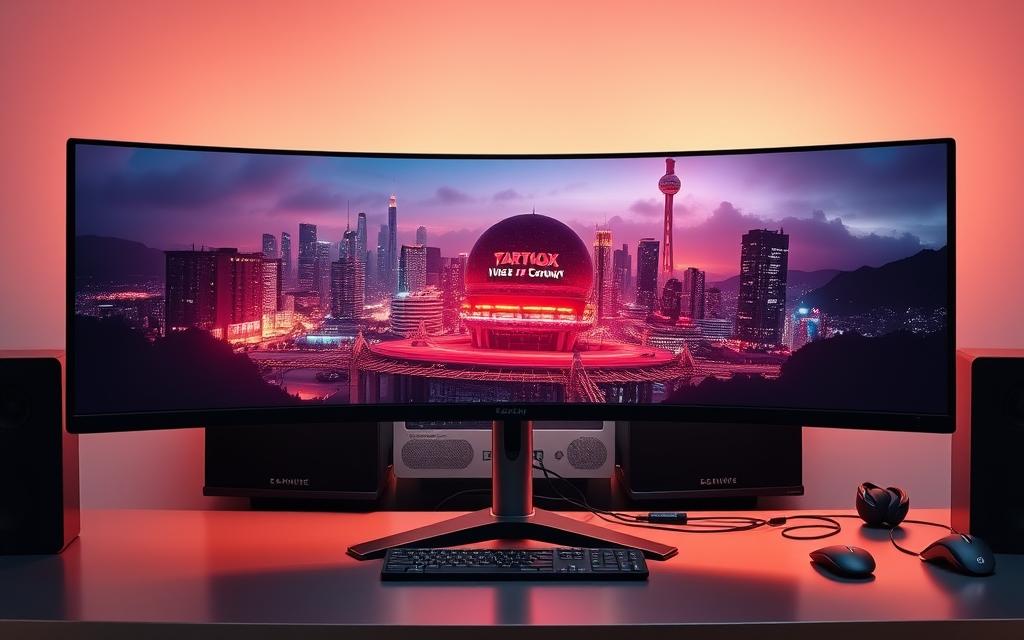
HP Omen 32q: Top 1440p Performer
The HP Omen 32q delivers 1440p clarity with a 165Hz refresh rate. Its IPS panel ensures vibrant colors and wide viewing angles, while AMD FreeSync Premium eliminates tearing. At $361.99, it’s a standout for competitive play.
Cooler Master GM34-CWQ ARGB: Best Ultrawide Option
For immersive gameplay, the Cooler Master GM34-CWQ ARGB shines. Its 3440×1440 21:9 aspect ratio wraps visuals around your field of view. The 144Hz refresh rate and VA panel (4000:1 contrast) excel in dark scenes, avoiding IPS glow.
Key features include:
- KVM switch: Control multiple devices with one setup.
- HDR400: Enhanced brightness for vivid highlights.
- 4 USB ports: Easy peripheral connectivity.
How does it compare to pricier ultrawides? Here’s a snapshot:
| Feature | Cooler Master GM34-CWQ ARGB | LG 34GP63A-B |
|---|---|---|
| Price | $259.99 | $499.99 |
| Panel Type | VA | IPS |
| Contrast Ratio | 4000:1 | 1000:1 |
For budget-conscious buyers, the Cooler Master offers elite specs at half the cost of premium rivals. Whether you prioritize speed or cinematic immersion, mid-tier models deliver exceptional value.
High-End Gaming Monitors ($500+)
Premium displays redefine competitive and immersive gameplay with cutting-edge specs. Beyond raw resolution, these models prioritize high refresh rates, color accuracy, and multi-device functionality. Whether you’re a professional esports player or a visual enthusiast, top-tier tech delivers unmatched performance.
HP Omen 27k: 4K Clarity Meets Speed
The HP Omen 27k excels with 3840×2160 resolution and a 144Hz refresh rate. Its IPS panel ensures vibrant colors, while DisplayHDR 400 enhances contrast for cinematic scenes. The built-in KVM switch lets users toggle between PCs or consoles seamlessly.
Color calibration out of the box is exceptional, covering 95% DCI-P3. For creative work or RPGs, this precision matters. At $549, it’s a standout for those prioritizing detail over extreme speed.
Gigabyte M27Q X: Esports Dominance
Competitive players demand the 240 refresh rate of the Gigabyte M27Q X. Its Super Speed IPS panel minimizes motion blur, critical for titles like Valorant or CS2. AMD FreeSync Premium eliminates tearing, while 1ms response time keeps action crisp.
How does it compare to the ASUS ROG Swift PG279QM? Here’s the breakdown:
| Feature | Gigabyte M27Q X | ASUS ROG Swift PG279QM |
|---|---|---|
| Price | $349.99 | $699.99 |
| Panel Type | Super Speed IPS | Fast IPS |
| Brightness | 320 nits | 350 nits |
For professionals, the Gigabyte’s value is undeniable. Pair it with an RTX 4080 to fully leverage its 1440p clarity and speed. KVM support also streamlines multi-device setups—ideal for streamers.
Curved vs. Flat Gaming Monitors
The battle between curved and flat screens comes down to immersion versus versatility. Each design excels in different scenarios, making the choice highly personal.
Curvature ratings like 1500R and 1800R define the viewing experience. Lower numbers mean a sharper curve:
- 1000R (Samsung Odyssey Neo G8): Wraps around your vision for intense immersion
- 1500R: Balanced curve for mixed-use setups
- 1800R (Samsung CF396): Gentle bend ideal for productivity
Racing and flight simulators shine on curved displays. The wider field of view mimics real-world peripheral vision, especially in ultrawide formats. Lenovo’s testing shows curved panels reduce eye strain during marathon sessions.
“A 1000R curve matches the human eye’s natural curvature, creating unparalleled depth in virtual environments.”
Productivity suffers slightly on curved screens. Text may appear distorted at the edges, and CAD work benefits from flat panels’ precise lines. The Samsung Odyssey series solves this with adjustable stands for optimal viewing angles.
Size matters when choosing curvature:
- Under 30″: Flat panels maintain clarity
- 30-40″: 1800R curvature enhances immersion
- 40″+: 1000R-1500R curves prevent neck strain
For competitive FPS players, flat screens still dominate. But RPG and simulation fans will prefer the cinematic feel of curved ultrawide displays like the Samsung Odyssey Neo G8.
OLED Gaming Monitors: Are They Worth It?
OLED technology has revolutionized display quality, but does it justify the premium price? These panels deliver perfect blacks and infinite contrast, creating visuals that LCDs can’t match. However, concerns about burn-in and higher costs make many gamers hesitate.
Modern OLED screens like the LG UltraGear 32GS95UV ($999) include protective measures. Pixel-shifting and automatic refreshes minimize burn-in risks during normal use. The Samsung Odyssey OLED G80SD takes it further with quantum dot enhancement for richer colors.
QD-OLED represents the latest advancement. This hybrid technology combines:
- Quantum dots for 99% DCI-P3 color coverage
- Faster response times (0.03ms)
- Wider viewing angles than WRGB OLED
The MSI MPG 321URX QD-OLED showcases these benefits with 4K resolution and 240Hz refresh. Compared to WRGB panels, it delivers:
| Feature | QD-OLED | WRGB OLED |
|---|---|---|
| Color Volume | Higher | Standard |
| Brightness | 1,000 nits peak | 800 nits peak |
| Pixel Layout | Triangular | Standard RGB |
For HDR enthusiasts with $1,000+ budgets, these displays offer unmatched immersion. The samsung odyssey oled series particularly shines in dark scenes, revealing details lost on other panels.
“QD-OLED’s color purity makes it the new gold standard for cinematic gaming.”
Casual players may find the investment hard to justify. But for competitive gamers and content creators, the visual fidelity warrants the price. As prices drop, OLED could become the new norm for premium setups.
Ultrawide Gaming Monitors for Immersive Play
Expansive screens redefine immersion with panoramic views. The Cooler Master GM34-CWQ exemplifies this with its 34-inch 144Hz curved display, wrapping gameplay around your field of vision. For under $300, the Dell S3422DWG delivers similar thrills with deeper blacks.
Aspect ratios dictate the experience. 21:9 models like the Philips Brilliance 499P9H excel at multitasking, while 32:9 beasts like the Samsung Odyssey OLED G9 create theater-like immersion. Key differences:
| Feature | 21:9 (3440×1440) | 32:9 (5120×1440) |
|---|---|---|
| Productivity | Dual-app split screen | Quad-app workspace |
| GPU Demand | RTX 4070 Ti | RTX 4080+ |
Driving these displays requires serious hardware. At 3440×1440, an RTX 4070 Ti maintains 100+ fps in AAA titles. The LG 49WL95C-W demands even more power—its 5120×1440 resolution strains mid-range cards.
Beyond gaming, these screens excel at productivity. Video editors gain timeline space, while streamers monitor chats without alt-tabbing. The Dell UltraSharp 38 USB-C Hub adds Thunderbolt connectivity for creatives.
“Ultrawides eliminate the need for multi-display setups while reducing bezel distractions.”
For those seeking Samsung Odyssey Neo G9 alternatives, consider the MSI MPG 491CQP. Its 32:9 curvature matches the Odyssey’s immersion at a lower price point. Just ensure your desk depth exceeds 30 inches for comfortable viewing.
Whether prioritizing racing sims or spreadsheet efficiency, ultrawide monitor gaming solutions deliver unmatched versatility. Pair them with high-refresh tech for both work and play dominance.
High Refresh Rate Monitors for Competitive Gaming
Professional esports players rely on ultra-responsive screens for split-second advantages. Displays with high refresh rates eliminate motion blur, giving competitors the edge in titles like Valorant and CS2. The Alienware AW2723DF exemplifies this with its 240Hz refresh rate.
Frame synchronization is critical for smooth gameplay. AMD FreeSync Premium and NVIDIA G-Sync prevent tearing when frame rates fluctuate. The Gigabyte M27Q X pairs its 240Hz panel with FreeSync for flawless performance.
Motion clarity separates premium displays. DyAc+ (BenQ) and ULMB (ASUS) technologies strobe backlights, reducing ghosting. The ASUS TUF VG259QM implements ULMB at 280Hz for crisp target tracking.
Panel types impact responsiveness:
- TN: Fastest response (0.5ms) but poor viewing angles
- Fast IPS: Balanced speed (1ms) with vibrant colors
- OLED: Near-instant response (0.03ms) with perfect blacks
NVIDIA Reflex certification matters for latency-sensitive games. The ASUS ROG Swift Pro PG248QP includes Reflex Analyzer to measure system delay. This helps optimize setups for tournament play.
| Model | Refresh Rate | Panel Type | Sync Tech |
|---|---|---|---|
| Alienware AW2524HF | 500Hz | TN | NVIDIA Reflex |
| Gigabyte M27Q X | 240Hz | Super Speed IPS | FreeSync Premium |
| ASUS ROG Swift OLED PG32UCDM | 240Hz | OLED | G-Sync Ultimate |
“At 500Hz, the Alienware AW2524HF delivers the fastest pixel transitions available—critical for professional tournaments.”
For serious competitors, 240Hz+ displays are non-negotiable. Pair them with GPUs like the RTX 4080 to maximize frame rates. Whether choosing TN for raw speed or OLED for contrast, prioritize refresh rate above all else.
Best Gaming Monitor Brands in 2025
Leading brands dominate the display market with distinct specialties. From OLED pioneers to esports specialists, each manufacturer carves its niche with tailored technologies. Understanding these differences helps buyers match brands to their priorities.
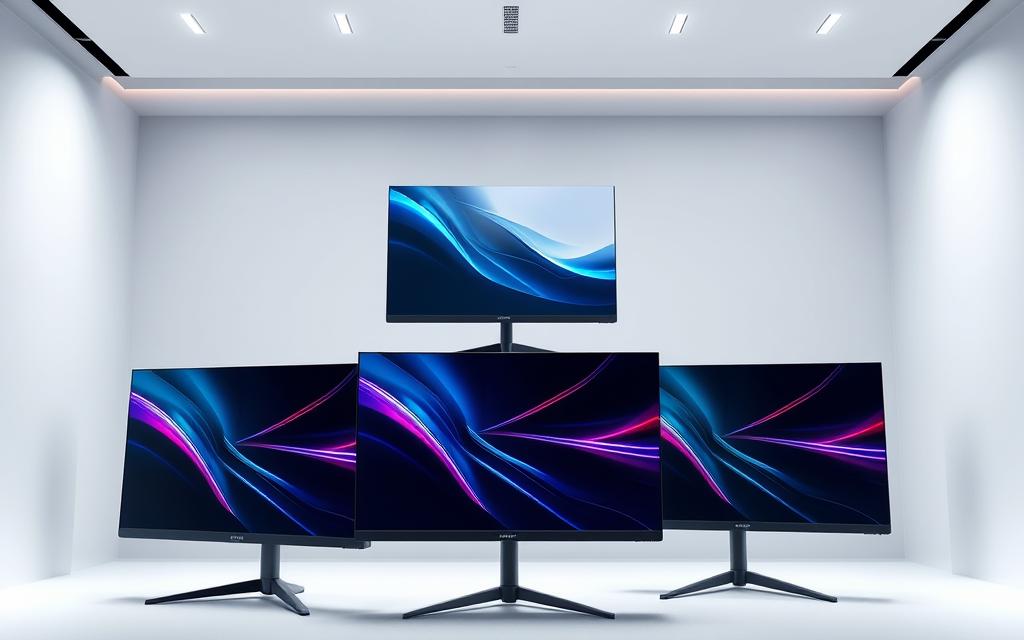
- Samsung leads OLED development with the Odyssey G9 G95SC, offering perfect blacks and quantum dot enhancement.
- ASUS dominates esports with the 540Hz ROG Swift PG248QP, featuring NVIDIA Reflex certification.
- ViewSonic delivers value with 3-year warranties on models like the XG2431.
- Cooler Master emerges as a budget ultrawide contender with the GM34-CWQ.
Warranty terms reveal brand confidence:
| Brand | Standard Warranty | Premium Coverage |
|---|---|---|
| ViewSonic | 3 years | Advanced replacement |
| Alienware | 3 years | On-site service |
| HP | 1 year | Extended purchase option |
Dell’s Alienware division pushes boundaries with the AW3423DW. Its QD-OLED panel combines 175Hz refresh rates with true HDR1400 certification. Meanwhile, the Samsung Odyssey series continues setting benchmarks for color volume.
“Cooler Master’s GM34-CWQ proves new entrants can compete by offering premium specs at mainstream prices.”
For budget-focused buyers, HP’s Omen line delivers reliable 144Hz performance. Those seeking the best gaming experience should consider the samsung odyssey OLED models. Between emerging brands and established leaders, 2025 offers more quality choices than ever.
Gaming Monitor Features You Shouldn’t Ignore
Beyond resolution and refresh rates, critical features shape your visual experience. Adaptive sync and color accuracy often determine whether a display meets professional standards. Let’s explore technologies that elevate gameplay and content creation.
AMD FreeSync vs. NVIDIA G-Sync
FreeSync offers cost-effective tear-free gameplay, widely compatible with AMD GPUs. The HP Omen 32q utilizes FreeSync Premium, ideal for budget-conscious setups. NVIDIA’s G-Sync provides stricter certification but demands premium pricing.
Key differences include:
- Refresh range: G-Sync handles wider fluctuations (1Hz-240Hz)
- Hardware: G-Sync requires proprietary modules
- Price: FreeSync monitors average 20% cheaper
HDR and Color Accuracy
HDR certifications reveal brightness capabilities:
| Standard | Brightness (nits) | Example Model |
|---|---|---|
| DisplayHDR 400 | 400 | HP Omen 32q |
| HDR1000 | 1000 | Samsung Odyssey Neo G8 |
| TrueBlack 400 | 400 (OLED) | Gigabyte FO32U2 Pro |
OLED panels inherently excel in HDR with perfect blacks. The samsung odyssey neo series demonstrates this with 2000-nit peak brightness. For content creators, 95% DCI-P3 coverage ensures accurate hues.
Calibration tools like the X-Rite i1Display refine color precision. Competitive gamers may prioritize speed, but HDR600+ transforms cinematic experiences. As displays evolve, these features become non-negotiable for premium setups.
Portable Gaming Monitors for On-the-Go Play
Mobile gamers need displays that keep up with their lifestyle without compromising performance. The ViewSonic VX1755 delivers with a 17.3-inch 144Hz panel that fits in most backpacks. At $229, it bridges the gap between desktop and travel setups.

USB-C Power Delivery is essential for these mini screens. Models like the Asus ROG Strix XG16AHPE include built-in batteries for cord-free use. Always verify your power adapter supports at least 45W output.
Screen protection separates good portables from great ones. The Arzopa Z1FC ships with a magnetic cover, while pricier options like the ViewSonic VX1655-4K-OLED use tempered glass. Consider foldable stands for cafe gaming.
Compared to tablets, these monitors offer:
- Lower input lag (often under 5ms)
- Higher refresh rates (up to 300Hz on the NexiGo NG17FGQ)
- Better compatibility with laptop GPUs
For Steam Deck and ROG Ally users, the Ricoh Portable Monitor 150BW shines. Its wireless connectivity eliminates cable clutter during travel. The 16:10 aspect ratio matches these handhelds perfectly.
“Portable monitors transform hotel rooms into esports arenas with desktop-grade responsiveness.”
Input lag tests show most mini displays perform within 2ms of their full-sized counterparts. Competitive players should prioritize models with AMD FreeSync like the ViewSonic VX1755. This ensures smooth gameplay even on battery power.
Gaming Monitor Size Guide: What’s Right for You?
Screen dimensions impact gameplay more than many realize. A 24-inch 1080p display offers 91 PPI (pixels per inch), while 27-inch 1440p models boost clarity to 108 PPI. This difference affects text sharpness and distant object visibility.
- 24-27″ for 2-4 feet (competitive FPS/MOBA)
- 27-32″ for 4-6 feet (RPGs/strategy)
- 32-40″ for 6-8 feet (racing sims)
Desk depth matters. 27-inch screens need 30-inch deep surfaces, while 34-inch ultrawide models require 36 inches. The Samsung Odyssey G93SC stretches to 49 inches—best for deep desks or wall mounts.
Field of view advantages vary by genre:
| Game Type | Ideal Size | Benefit |
|---|---|---|
| FPS | 24-27″ | Eyes track entire screen |
| RPG | 27-32″ | Immersive landscapes |
| Racing | 34″+ | Peripheral vision |
“27-inch 1440p strikes the sweet spot for most setups—sharp enough for work, responsive for play.”
Super ultrawides like the 5120×1440 Samsung Odyssey Neo G9 demand premium GPUs. For balanced performance, 27-32-inch displays with 1440p resolution suit most desktop arrangements.
Remember: Bigger isn’t always better. Prioritize pixel density and viewing comfort over raw screen real estate.
Where to Buy Gaming Monitors for the Best Deals
Smart shoppers know the right retailer makes all the difference in display pricing. From seasonal discounts to certified refurbished units, strategic buying unlocks premium specs without overspending.

Amazon dominates with frequent price drops and Prime Day exclusives. Tools like Camelcamelcamel track historical lows, alerting buyers to ideal purchase windows. For open-box steals, Best Buy offers tested units at 15–30% discounts, often with full warranties.
Refurbished programs provide another budget-friendly path. The Dell Outlet stocks recertified Alienware screens, while HP Renew backs products with 1-year guarantees. These options deliver near-new performance at reduced costs.
“Black Friday isn’t the only savings window—July and January clearance events often beat holiday prices.”
Credit card price protection can secure refunds if costs drop post-purchase. Retailers like Newegg extend return windows during holidays, reducing buyer risk. Always compare policies—Micro Center’s 30-day guarantee outperforms Walmart’s 15-day limit.
For cheap gaming monitors, prioritize retailers with robust customer service. B&H Photo’s no-restocking-fee returns and Adorama’s bundle deals add value beyond upfront savings. Whether hunting 4K screens or high-refresh panels, timing and research maximize every dollar.
How to Choose the Right Gaming Monitor for Your Setup
Your setup deserves a screen that matches both performance and spatial constraints. The best gaming displays balance resolution, refresh rates, and ergonomic features tailored to your hardware and environment.
Start by pairing resolution with GPU power. An RTX 4060 handles 1080p effortlessly, while 1440p demands at least an RTX 4070. PCMag’s testing shows 4K requires flagship cards like the RTX 4080 Super for consistent frame rates.
“Mismatched GPU-display combos waste either visual fidelity or performance—measure your card’s benchmarks before choosing pixels.”
Desk mounting expands placement options. VESA-compatible arms like the Ergotron LX save space and improve posture. For ultra-wide screens, consider wall mounts with 45-degree tilt to reduce neck strain.
Cable management keeps battlestations clean:
- Magnetic clips route wires along desk edges
- Under-desk trays hide power bricks
- Braided sleeves bundle multiple connections
Ambient lighting affects visibility. Bias lighting behind screens (like the Luminoodle RGB) reduces eye fatigue during night sessions. Avoid direct sunlight on panels to prevent glare and color distortion.
Content creators should prioritize calibration tools. The X-Rite i1Display Pro ensures accurate colors for streaming and editing. Most best gaming monitors now include sRGB and DCI-P3 presets for quick adjustments.
Remember: The perfect display fits your physical space as much as your performance needs. Measure twice, buy once.
Conclusion
Display technology evolves rapidly, offering more choices than ever for players. The best gaming monitors balance performance and value, like the 144Hz Acer Nitro VG240Y for budget gaming or the Dell S2721DGF for sharper 1440p visuals.
OLED panels and 500Hz refresh rates push boundaries, ideal for competitive play. Future-proof your setup with higher resolutions—1440p or 4K—to maximize longevity.
Track deals on Amazon or DealNews to snag premium specs at lower prices. Whether upgrading or building fresh, the right display transforms your experience.



